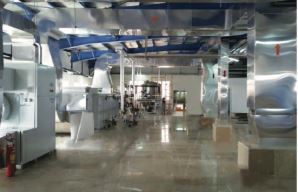Smart Cleanrooms: IoT & Remote Monitoring
introduction
Smart cleanrooms leverage Internet of Things (IoT) technologies and remote monitoring platforms to transform traditional controlled environments into adaptive, data‑driven spaces. By embedding sensors into modular components—clean room panels, HEPA filtration units, and HVAC systems—healthcare facilities gain continuous visibility into particulate levels, pressure differentials, temperature, and humidity. This real‑time insight enables proactive contamination control, predictive maintenance, and simplified regulatory compliance under ISO 14644‑1, EU GMP Annex 1, and FDA 21 CFR Part 11. In 2025, digital twins, edge analytics, and cloud dashboarding are central to smart cleanroom systems, reshaping how hospitals and labs manage sterile environments. Finally, we’ll show how Ultravision integrates mrc cleanrooms into turnkey hospital cleanroom projects, backed by full healthcare solutions across the UAE and Dubai.


The Rise of Smart Cleanrooms
What are Smart Cleanrooms?
A smart cleanroom integrates networked IoT sensors directly into its infrastructure: from GRP clean room panels to HEPA Fan Filter Units (FFUs) and ductwork. These sensors continuously track critical parameters and feed data to edge gateways for real‑time analytics and alerting.
Why Healthcare Needs Smart Cleanroom Systems
Periodic manual sampling can miss transient contamination events. Smart cleanrooms provide 24/7 monitoring, so deviations in particulate counts or pressure cascades trigger immediate corrective actions—vital in ISO 5 compounding suites and ISO 7 prep zones.
Enabling Technologies for Smart Cleanrooms
IoT Sensors & Connectivity
Key sensor types in smart cleanroom systems include:
- Particle Counters embedded in FFUs for real‑time particulate monitoring.
- Differential Pressure Transmitters to maintain pressure hierarchies.
- Temperature & Humidity Probes ensuring climate stability.
- Chemical/VOC Sensors for aseptic area safety.
Connectivity via industrial Wi‑Fi, private 5G, or LPWAN links sensors to edge gateways.
Edge Analytics & Digital Twin Models
Edge gateways run local analytics—detecting anomalies before they become issues. Digital twins mirror the physical modular cleanroom, simulating airflow and contamination patterns to optimize layout and maintenance without disrupting operations.
Cloud Dashboards & Remote Oversight
Cloud platforms aggregate sensor data into unified dashboards offering:
- Real‑Time Metrics on particles, pressure, and climate.
- Alert Management via email/SMS for out‑of‑spec events.
- Historical Reporting for audits and trend analysis.
Multi‑site views allow central teams to oversee hospital cleanroom estates.
Key Benefits of Smart Cleanrooms
Improved Compliance & Audit Readiness
Continuous, timestamped logs fulfill ISO 14644‑1, EU GMP Annex 1, and FDA Part 11 requirements—eliminating manual charting and bolstering inspection readiness.
Predictive Maintenance & Uptime
By tracking filter differential pressures and fan health signatures, smart cleanroom systems predict HEPA or motor failures, enabling maintenance during planned windows rather than reactive shutdowns.
Energy & Operational Efficiency
Automated fan speed control based on real‑time contamination and occupancy can reduce HVAC energy use by up to 20 %. Triggered cleaning workflows focus staff on highest‑risk areas only.
Data‑Driven Process Optimization
Detailed contamination heat‑maps from mobile sensor units help identify “dead zones.” Facilities can retrofit additional FFUs or realign clean room panels for uniform airflow.
Implementing Smart Cleanroom Projects
1. Assessment & Requirements Gathering
Audit existing cleanrooms for pain points—intermittent pressure failures or inconsistent particle counts. Define new URS to layer IoT onto mrc cleanrooms GRP panels and HEPA modules.
2. Pilot Installation
Select an ISO 7 zone to pilot. Install wireless particle counters, pressure meters, and climate probes. Validate connectivity to edge gateways and set alert thresholds before full rollout.
3. Full‑Scale Deployment
Standardize sensor placement (e.g., one particulate counter per 10 m²). Leverage modular cleanroom prefabrication to embed sensor mounts during factory build, reducing on‑site labor.
4. Validation & Qualification
Update IQ/OQ/PQ protocols to include IoT:
- IQ: Verify sensor installation, calibration, and network connectivity.
- OQ: Simulate excursions to test alarm responses.
- PQ: Confirm continuous monitoring during routine tasks.
5. Continuous Improvement
Use trend analytics to refine setpoints and optimize energy‑contamination trade‑offs. Run digital twin scenarios for future expansions or configuration changes without risking production.
Challenges & Mitigation in Smart Cleanrooms
Cybersecurity & Data Integrity
IoT increases risk surface. Implement end‑to‑end encryption (TLS/SSL), secure firmware updates, and network segmentation to protect sensor and BMS data.
Legacy System Integration
Older BMS or HVAC platforms may lack IoT compatibility. Use protocol converters (BACnet‑to‑MQTT) and phased upgrades to integrate seamlessly.
Change Control & Qualification
Adding sensors is a controlled change. Update URS, risk assessments, and re‑validate per your quality management procedures to ensure continued compliance.
Frequently Asked Questions
What makes a cleanroom “smart”?
Embedding IoT sensors for real‑time monitoring and analytics, versus periodic manual checks.
How do smart cleanrooms aid compliance?
They provide continuous, timestamped data logs that satisfy ISO 14644, EU GMP, and FDA Part 11 documentation requirements.
Can modular cleanroom panels support IoT sensors?
Yes—mrc cleanrooms GRP and HPL panels can be factory‑fitted with sensor mounts and wiring channels.
Which network is best for cleanroom IoT?
Private 5G or industrial Wi‑Fi for high‑reliability, low‑latency data; LPWANs for low‑bandwidth points.
How do digital twins enhance operations?
They simulate contamination and airflow “what‑if” scenarios, guiding layout and maintenance decisions without downtime.
Is cybersecurity a concern?
Absolutely—secure device provisioning, encryption, and regular vulnerability assessments are mandatory.
What ROI do smart cleanrooms deliver?
Typical benefits include 15–25 % energy savings, 30 % fewer emergency repairs, and reduced audit overhead.
How are alarms managed?
Edge gateways filter noise and forward only critical events to cloud dashboards for email/SMS alerts.
Do smart cleanrooms need new validation protocols?
Yes—IQ/OQ/PQ must cover sensor installation, calibration checks, and alarm response tests.
Can smart cleanroom data integrate with hospital systems?
Yes—APIs and OPC UA connectors link to BMS, LIMS, and CMMS for unified facility management.
Ultravision’s Smart Cleanrooms with mrc cleanrooms
Ultravision Medical Equipments delivers turnkey smart cleanrooms featuring mrc cleanrooms with IoT‑ready GRP panels, HEPA FFUs, and centralized monitoring. As leading medical equipment suppliers in UAE and medical equipment suppliers in Dubai, we execute medical projects from sterile compounding suites to diagnostic labs, backed by preventive medical equipment repair, staff training, and ultrasound machines integration. Our end‑to‑end healthcare solutions keep your hospital cleanroom at the cutting edge of contamination control and operational excellence.

